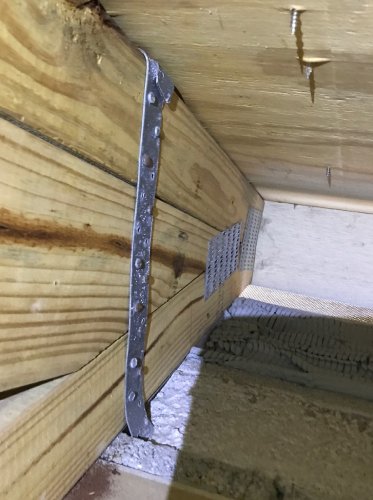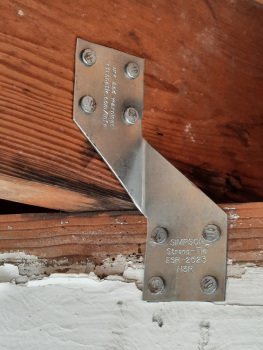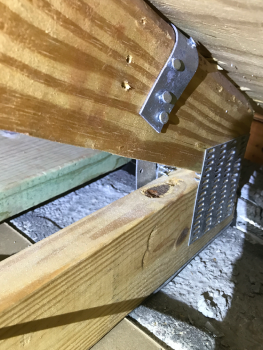When fierce winds howl, roof wall connections become a building’s best friend. They aren’t just pieces of metal; they’re the unsung heroes that help roofs stay put during storms. In hurricane-prone areas like Florida, these connections can be lifesavers. Folks often wonder how these ties, clips, and straps impact insurance. Well, having them can mean fewer worries and lower costs. Insurance companies love when homes are fortified with hurricane straps and clips, offering discounts for those who take action. Installing hurricane ties and other connectors isn’t just about safety. It’s about playing it smart with insurance. Understanding the role of these connections and building codes is crucial for both peace of mind and pocket.

The Critical Importance of Roof-to-Wall Connections
Roof wall connections hold everything together when storms rage. They act like the glue that keeps your roof attached to your home. Hurricane ties and clips are the key players here. These metal connectors reinforce the structure, stopping your roof from flying off. In Florida, homes often need these ties due to local building codes. Proper installation can save a fortune. Many insurers offer discounts when homes meet these standards. Curious about installation costs? The savings on insurance could outweigh the initial investment. According to experts at FEMA, maintaining a “continuous load path” is crucial during severe wind events, ensuring safety and peace of mind.
The Science behind Roof Wall Connections and Safety
When exploring the mechanics of how roofs meet walls, safety emerges as a key player. Roof wall connections create a unified force against nature’s whims, channeling wind forces seamlessly to the foundation. This strategy is crucial in preventing roofs from taking flight during storms. The use of hurricane clips is a critical—these hold your roof in place. Meanwhile, hurricane roof strap installations further bolster security, especially in storm-prone Florida. Adhering to building codes ensures not just safety but also insurance perks. The cost of implementing these hurricane tie-down straps pales in comparison to potential insurance savings. By weaving wind mitigation techniques into construction, homeowners stand to gain both financial and safety advantages. As they say, an ounce of prevention is worth a pound of cure.
Unraveling the Types of Roof Wall Connections
Peeling back the layers of roof wall connections reveals a hidden world of structural safety. These connections come in various forms, each serving a unique purpose. Here’s a short list:
-clips
-single straps
-double straps
-toenails
-Sanibel strap
In Florida, where hurricanes are frequent, these ties are mandatory. They help meet the building standards and contribute to insurance savings. The initial hurricane strap retrofit cost will be about the same as 2 hurricane impact windows making them a clear winner in terms of return on investment. They reduce repair needs after storms, offering both financial and emotional peace. When properly installed, hurricane clips hold firm against the wind, safeguarding the home. These ties are essential for anyone wanting a sturdy, storm-resistant home.
How Roof Wall Connections Affect Insurance
Exploring how roof wall connections influence insurance reveals a world of potential savings. Well-installed hurricane straps can be a game-changer for insurance premiums. Many insurers reward homeowners who meet building codes, providing discounts for reinforced roof connections. The process to install hurricane straps may seem straightforward, but it requires accuracy.
In Florida, building mandates require hurricane ties and clips to ensure homes withstand extreme weather. This not just reinforces safety but also impacts insurance rates positively. Roof strap building experts recommend inspections to verify compliance.
For homeowners, meeting these regulations is like hitting a jackpot—protection and savings. When hurricane clips are in place, the roof stays anchored, offering peace of mind during storms. Investing in these connections is investing in both safety and financial relief.
The Impact of Hurricane Straps on Insurance Costs
Examining how hurricane ties influence insurance reveals notable savings opportunities. Properly installed hurricane clips can significantly lower premiums. Insurance companies often offer discounts when roof connections meet stringent building codes. For homeowners, this means protection and financial benefits.
In Florida, stringent codes require hurricane ties to safeguard structures against extreme weather. Compliance not just ensures safety but also positively impacts insurance costs. Roof strap building specialists emphasize inspections to confirm adherence.

Adherence to Florida Building Codes: A Necessity
Following Florida’s building codes isn’t just a good idea—it’s a must. Especially concerning roof wall connections, these regulations ensure safety during fierce storms. In a hurricane-prone area like Florida, these connections are crucial. They keep roofs securely attached to walls, protecting the entire structure. Without this, a house could face catastrophic damage.
For new builds or major renovations, these codes require using metal connectors. These are often referred to as hurricane ties or clips. Proper installation is key and can even impact insurance costs. Homeowners might find themselves with reduced premiums, a sweet bonus for following the rules. Strengthening these connections is not just a recommendation but a practical step toward safety.

5 Steps to Install Roof Wall Connections Correctly
To install roof wall connections with precision, start by having a roofer inspect your current setup. An inspector can then assess and recommend any needed upgrades. When replacing the roof, ensure you can easily access rafters and wall plates for installing clips. Secure these with the recommended nail count, making sure each connection is secure. Hurricane clips play a crucial role here, enhancing the roof’s grip on the walls. Once everything is in place, a building inspector must verify that the setup meets local codes. This inspection is your ticket to avoid future headaches and ensure the safety of your home. In a place like Florida, hurricane ties are truly indispensable.
FAQ
- What are roof wall connections, and why are they important?
Roof wall connections are essential for keeping a building stable during high winds. They ensure the roof stays attached to the walls, which is crucial during storms. Using metal connectors like hurricane ties can strengthen these connections.
- How do hurricane ties and clips improve roof safety?
Hurricane ties and clips help resist uplift forces. They keep the roof attached to the building during strong winds. Proper installation following local codes is key to their effectiveness.
- Can roof wall connections impact my insurance costs?
Yes, they can. Installing hurricane straps correctly might lower insurance premiums. Insurers often offer discounts for homes with wind-damage mitigation features like reinforced roof connections.
- Are there building codes related to roof wall connections in Florida?
Yes, Florida mandates specific building codes for hurricane ties. New constructions and major roof replacements must follow these codes, affecting insurance eligibility and costs.
- What steps are involved in installing roof wall connections?
First, a roofer inspects the current connections. Then an engineer assesses their strength and suggests upgrades. Next, during roof replacement, hurricane clips are added. Finally, a building inspection ensures code compliance.
